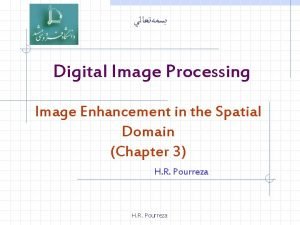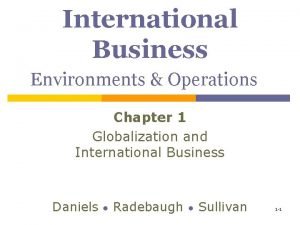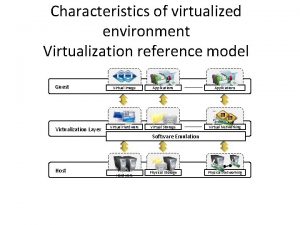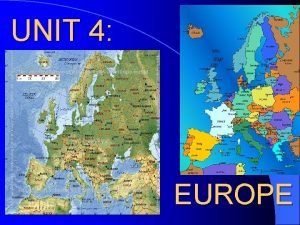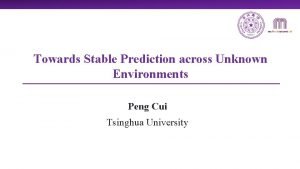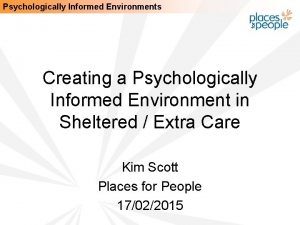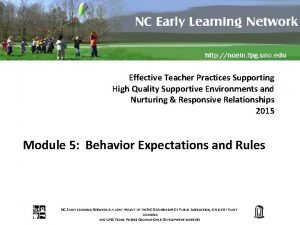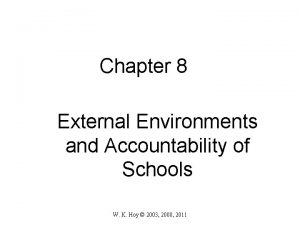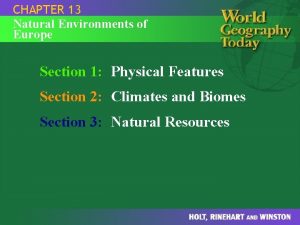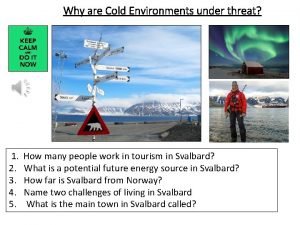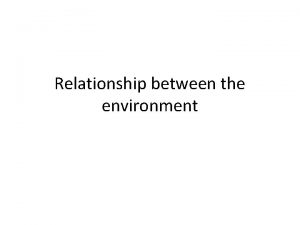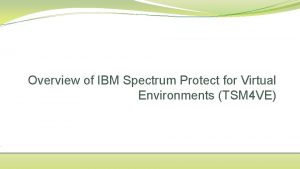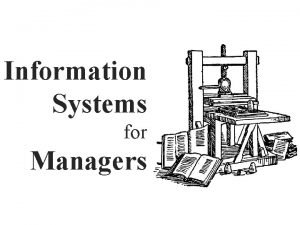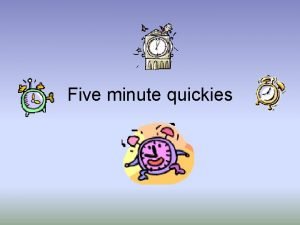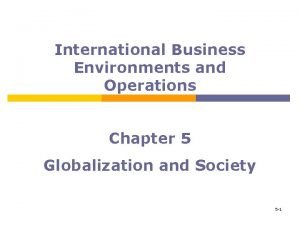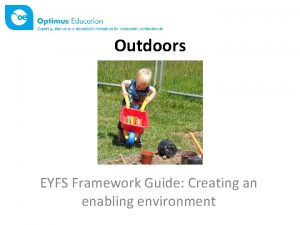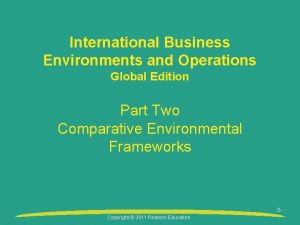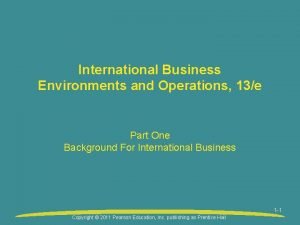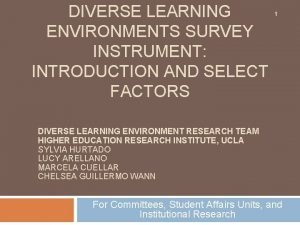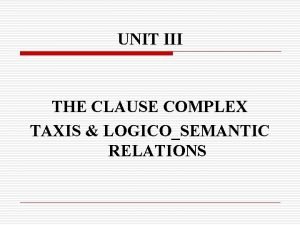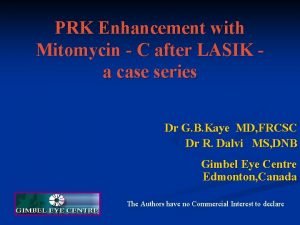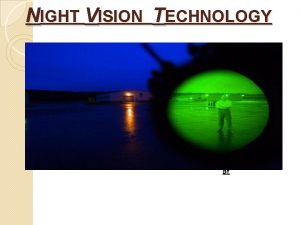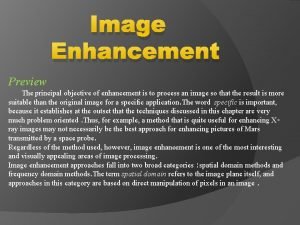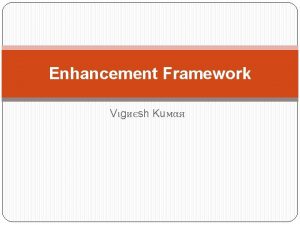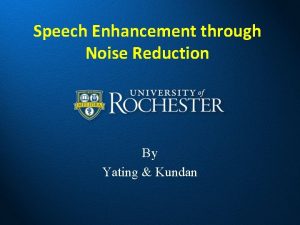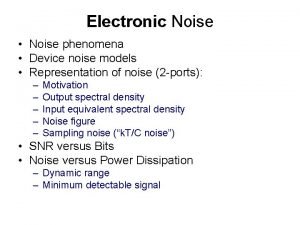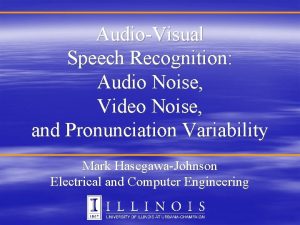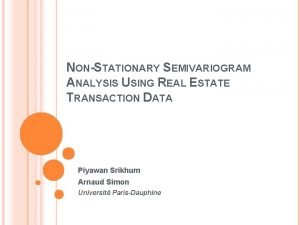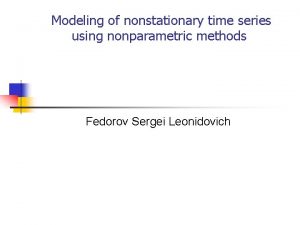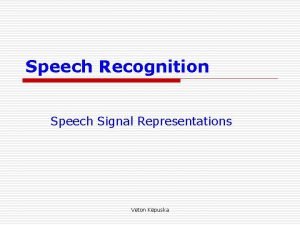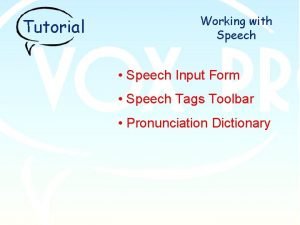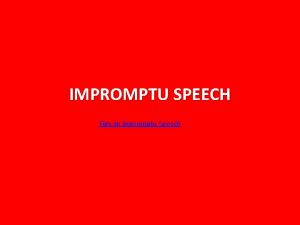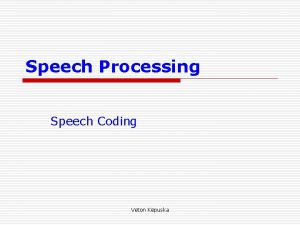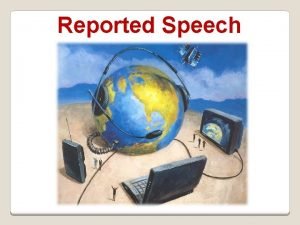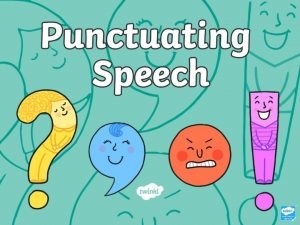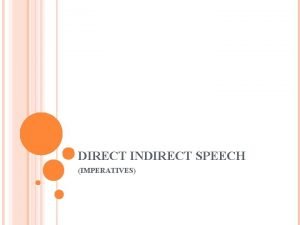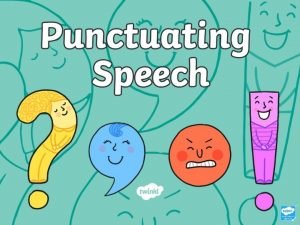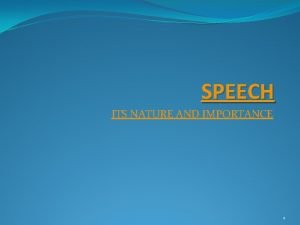Speech enhancement in nonstationary noise environments using noise




































- Slides: 36

Speech enhancement in nonstationary noise environments using noise properties Kotta Manohar, Preeti Rao Department of Electrical Engineering, Indian Institute of Technology, Powai, Bombay 400 076, India Presenter: Shih-Hsiang(士翔) 1 SPEECH COMMUNICATION 48 (2006)

Reference o o o K. Manohar and P. Rao, "Speech enhancement in nonsataionary noise environments using noise properties", Speech Communication, 48 , (2006) V. Stahl, A. Fischer, and R. Bippus, "Quantile Based Noise Estimation for Spectral Subtraction and Wiener Filtering, " in Proc. ICASSP, 2000, vol. 3, pp. 1875— 1878 M. Berouti, R. Schwartz, J. Makhoul, "Enhancement of speech corrupted by acoustic noise. " in Proc. ICASSP, 1980, pp. 208– 211 2

Introduction o Signal-channel speech enhancement algorithms are generally base on short-time spectral attenuation (SATA) n Applying a spectral gain to each frequency bin in a short-time frame of the noisy speech signal, then the gain is adjusted individually as a function of the relative local SNR at each frequency o n o o Spectral Subtraction (SS), MMSE short-time spectral amplitude estimator With low SNR regions attenuated relative to high SNR regions A good estimate of the instantaneous noise spectrum is crucial in the estimation of the local SNR A common method of noise estimation involves the use of a voice activity detector (VAD) to detect the pauses in speech n The noise estimate is then obtained by a recursively smoothened adaptation of noise during the detected pause 3

Introduction (cont. ) o In stationary background noise, such an estimator is generally reliable n However nonstationary noises cannot be tracked adequately by a recursive noise estimation method that adapts only during detected speech pauses o o o E. g. factory, battlefield noise Even the VAD is reliable, changes in the noise spectrum occurring during active speech cannot influence the noise estimate in a timely manner STAT-based algorithms are effective only in suppressing the stationary noise component generally leaving noise bursts unattenuated in the enhanced speech 4

Introduction (cont. ) o In this paper, a method which exploits known differences in the spectro-temporal properties of noise and speech to selectively attenuate noisy time-frequency regions remaining in STSA-enhanced signals 5

Suppressing nonstationary noise o The proposed solutions generally fall into two categories n n o Improvements to the noise estimator Modification of the suppression rule A number of methods for noise spectrum estimation without explicit speech pause detection have been proposed n n Based on tracking some statistic (e. g. minimum, median) of past power spectral values for each frequency bin over several frames (e. g. QBNE) However the buffer length necessary to bridge peaks of speech activity makes it difficult to follow any rapid variations in noise spectrum 6

Suppressing nonstationary noise (cont. ) o A brief introduction to QBNE (Quantile Based Noise spectrum Estimation) n n In speech section of the input signal not all frequency bands are permanently occupied the energy in each frequency The noise estimate N(ω) are taking the q-th quantile over time in every frequency band For every ω the frames of the entire utterance X(ω, t), t=0, …, T are sorted such that X(ω, t 0)≤ X(ω, t 1) ≤… ≤ X(ω, t. T). The q-quantile noise estimation is defined as 7

Suppressing nonstationary noise (cont. ) QBNE method a buffer of 0. 64 s duration and quantile value 0. 5 Factory noise is nonstationary in nature having stationary noise background with occasional random bursts to which the sudden peaks in the instantaneous noise power spectra VAD estimator tracks the noise burst level only when speech is absent The QBNE estimator responds to the noise burst only approximately and with a delay These direct estimation methods for noise fail in conditions such as factory noise 8

Suppressing nonstationary noise (cont. ) o A different approach to carry out the adaptation of noise during both speech absence and presence is via a speech absence probability based on an estimate of SNR (Malah et al. , 1999)(Cohen 2003) n o Any sudden increase in the background noise level is not easily distinguished from speech and results in high estimated SNR making the method relatively less effective in highly nonstationary noise No direct methods can track highly nonstationary noises accurately even if the noise estimate is updated in every frame 9

Suppressing nonstationary noise (cont. ) o Cooke et al. (2001) propose missing data methods for robust ASR n A two-stage approach is used o o n o Spectral subtraction is employed to suppress the stationary noise component The recognition processor is conditioned on the estimated reliability of spectro-temporal regions of the signal as determined by various speech spectrum cues Difficulty of detecting unreliable regions when the nonstationary noise component is intermittent and impulsive A similar concept applicable to speech enhancement is the use of statistical models of clean speech or trained codebook where a priori information in the form of spectral envelope shapes is stored for both speech and noise n n A joint or iterative optimization over assumed speech and noise models is carried out for each frame of noisy speech to determine the noise estimate The performance would be expected to depend critically on a good match between training and actual usage conditions 10

Suppressing nonstationary noise (cont. ) o This paper is targeted towards a robust algorithm for suppression of random noise bursts with minimal speech distortion n o Using available knowledge to distinguish between speech and noise in order to identify, and further attenuate, unreliable spectro-temporal regions in signals enhanced by traditional STSA To achieve improved speech quality using this approach requires solutions to two problems n n determining reliable cues for identifying noisy spectro-temporal regions finding a suitable suppression rule applicable to the detected noisy regions so as to achieve significant reduction of noise with minimal speech distortion. 11

Proposed post-processing algorithm o The proposed post-processing algorithm involves identifying regions in the spectrogram of the STSA-enhanced speech that are dominated by the residual noise n o These regions are selectively attenuated further with the goal to improve the overall quality of the enhanced speech The post-processing scheme thus comprises the following steps: n n n Divide the spectrum of each frame of the STSA enhanced speech into several frequency bands, possibly overlapping, frequency band in view of the fact that the noise spectrum may be localized in frequency Carry out speech/noise classification to detect frequency bands that are dominated by residual noise Using a suitable suppression rule, attenuate the spectral values in the identified noisy bands 12

Proposed post-processing algorithm (cont. ) o The suppression rule should ideally depend on the bin SNR in a manner as to apply more attenuation in low SNR regions n o This would help to minimize speech distortion while achieving an overall improvement in the SNR If the identification of noisy frequency bands in Step 2 is reasonably reliable, a local SNR increase in an identified nonspeech bin would signal the onset of a noise burst. An appropriate definition for the estimated SNR is given by the ‘‘average a priori SNR’’ computed as in where current SNR previous SNR The average noise power spectrum estimate as obtained from the noise estimator of the STSA 13

Proposed post-processing algorithm (cont. ) o The attenuation factor λ(k) is varied linearly with the estimated a priori SNR ζ(k) in d. B but restricted to the range of 0. 05 -0. 9 f 0 is the value at 0 d. B SNR, and s is the slope of the line 0. 9 0. 05 SNR_low SNR_high SNR(d. B) 14

Proposed post-processing algorithm (cont. ) o o The suppression rate can be controlled by varying the parameters ‘SNR_low’ and ‘SNR_high’ After obtaining the attenuation factors, recalculate the speech estimate as follow of an i-th ‘noisy band’ limiting the value to a spectral floor the spectral floor gain parameter 15

Spectral flatness based classifiers o o Based on the assumption that the STSA enhanced speech contains primarily harmonic speech and frequency-localized noise bursts Let X[k] denote the magnitude spectrum values computed via a DFT. The ith frequency band comprises L frequency bins with bin index k in the range [bi, ei] n o For instance, with a 256 -point DFT at sampling frequency of 8 k. Hz, the 0 – 1 k. Hz band will be bounded by the bin indices: bi = 0 and ei = 31 The measures investigated are: n SFM (spectral flatness measure): It is defined as the ratio of the geometric mean to the arithmetic mean of the magnitude spectrum values taking low values for harmonic regions representing speech, and High values for noise-dominated regions which have a relatively flat spectrum 16

Spectral flatness based classifiers (cont. ) n Energy-normalized variance: The harmonic structure or deviation from flatness of the spectrum in any chosen frequency band is reflected in the energy-normalized variance of the spectral values high values for harmonic regions representing speech, and low values for noise-dominated regions, n Entropy: A related measure is ‘‘entropy’’ as used in the VAD of Renevey and Drygajlo (2001) on the assumption that the signal spectrum is more organized during speech segments than during noise segments where H takes maximum value of ‘ 1’ when the signal is a white noise, and minimum value of ‘ 0’ when it is a pure tone (sinusoid). Hence, the entropy based method is well suited for speech detection in white or quasi-white noise 17

Experimental comparison of classifier o A comparative evaluation of the different classifiers can be achieved by experimental observations in a typical application situation n o o i. e. by comparing the receiver operating characteristics (ROC) or the hit rate versus false-alarm rate plots A better classifier would be characterized by a lower falsealarm rate for a given hit rate The steepness or slope of the ROC curves determines the suitability of the feature in terms of providing an adequate level of discrimination between speech and noise 18

Experimental comparison of classifier (cont. ) ROC plots of the energy-normalized variance, SFM and entropy in the detection of noisy 19 regions for factory noise-corrupted speech at 0 d. B SNR

Experimental evaluation o The performance is evaluated for three real environmental noise viz. factor noise, machine gun noise, and train interior noise n o Two standard STSA algorithms are chosen as the front-end STSA algorithms n n o All the three noises are highly fluctuating, characterized by random energetic bursts Berouti spectral subtraction (BSS) Multiplicatively modified log spectral amplitude estimator (MM-LSA) In all experiments, a 32 ms Hamming window with 50% overlap is applied to 8 k. HZ sampled speech. The spectrum is computed using a 256 -point DFT 20

Experimental evaluation (cont. ) o Noise properties and post processing parameter settings n n n Factory noise : contains randomly occurring events such as hammer blows embedded in a more homogenous background noise Machine gun noise : a series of gunshots recorded in a quiet environment, in order to make it more realistic, a white background noise Train noise : it is sound recorded in the interior of an Indian electric train with windows open (i. e. the noise arises from the moving mechanical parts of the train) 21

Experimental evaluation (cont. ) Spectrograms of segments of (a) factory, (b) train and (c) machinegun noise 22

Experimental evaluation (cont. ) o Noise properties and post processing parameter settings The frequency bandwidth for the variance-based noise detection is selected to provide a high-frequency resolution for noisy region detection The choice of decision threshold the detection of noise-dominated bands should be based on the desired hit rate or tolerable false-alarm rate. A low false-alarm rate helps to minimize speech distortion The parameters SNR_low and SNR_high determine the amount of attenuation as a function of the estimated a priori SNR 23

Experimental evaluation (cont. ) o Measuring speech quality improvement n n o Naturalness and Intelligibility of speech output are important attributes of the performance of any speech enhancement system Since achieving a high degree of noise suppression is often accompanied by speech signal distortion, it is important to evaluate both quality and intelligibility Subjective listening tests are the best indicators of achieved overall quality n A–B comparison tests of sentences processed by competing processing methods can be used to obtain comparative quality rankings o n The chief attributes tested here are the naturalness or overall quality of the processed speech Speech intelligibility is tested by the SUS (semantically unpredictable sentences) test, originally proposed for evaluating synthetic speech (Benoit et al. , 1996) 24

Semantically Unpredictable Sentences (SUS) o Comparative evaluation of sentence intelligibility, minimizing the effect of contextual cues. Short, semantically unpredictable sentences of five different, common syntactic structures with words randomly selected from lexicons with frequent "mini-syllabic" words (smallest words available in a given category): n n n Subject - Verb - Adverbial, e. g. , The table walked through the blue truth Subject - Verb - Direct object, e. g. , The strong way drank the day Adverbial - Transitive verb - Direct object (imperative), e. g. , Never draw the house and the fact Q-word - Transitive verb - Subject - Direct object, e. g. , How does the day love the bright word? Subject - Verb - Complex direct object, e. g. , The place closed the fish that lived. 25

Experimental evaluation (cont. ) o Overall quality ranking is A–B comparison involving four listeners and eight distinct sentences from the TIMIT database (Fisher et al. , 1986) , each from a different speaker (four male and four female) n n o Each sentence pair presented for listening comparison comprises of the processed versions of a single sentence, before and after postprocessing To avoid bias, the order A and B are interchanged and randomized across sentences and listeners Speech intelligibility is tested by the SUS n n Thirty SU sentences, six of each of five syntax structures, were generated and played in random order to each of four listeners who were asked to write down the sentences they hear To avoid listener familiarity with a specific noise sample, segments of the noise file to be added to the sentences were chosen randomly from a larger noise sample and digitally added to the clean speech 26

Experimental evaluation (cont. ) o There a large number of objective measures that quantify the degradation in quality of processed speech with respect to a reference speech sample n o However, not all objective measures may be appropriate for specific kinds of distortion Use PESQ and WSS in the experiments to measure quality gains, if any, achieved due to post-processing 27

Weighted Spectral Slope Measure o o o The weighted spectral slope (WSS) measure is based on an auditory model in which 36 overlapping filters of progressive larger bandwidth are used to estimate the smoothed shorttime speech spectrum The measure finds a weighted difference between the spectral slopes in each band The magnitude of each weight reflects whether the band is near a spectral peak or valley, and weather the peak is the largest in the spectrum the difference between overall sound pressure level of the original and processed utterances Ks is a parameter which can be varied to increase the overall performance. 28




Result and discussion there is a clear listener preference for the post-processed speech over that before post-processing The percentage word intelligibility scores averaged across the listeners are 60. 7, 51. 7 and 50. 6 at 3 d. B SNR for the three configurations of noisy, BSS and BSS + PP respectively 32

Result and discussion (cont. ) Narrowband spectrograms of (a) clean, (b) noisy, (c) BSS-enhanced speech and (d) after post-processing, for a speech segment in factory noise 33

Result and discussion (cont. ) The WSS distance indicates a consistent decrease (implying an improvement in quality) with post-processing from that obtained with STSA enhancement alone The PESQ MOS on the other hand is consistent with the subjectively perceived trend of an improvement in speech quality with STSA enhancement over that of noisy speech, Both the objective measures indicate that post-processing has a greater influence at the lower SNRs 34 relative to that at higher SNRs.

Result and discussion (cont. ) the performance gains due to post-processing do not change significantly with the change in the algorithm parameters 35

Conclusion o o o Traditional STSA speech enhancement algorithms perform inadequately in application to speech corrupted by highly nonstationary noise With limited added complexity, the post-processing algorithm is effective in significantly reducing the perceived effects of the noise bursts at low SNRs without further speech distortion While the onsets of noise bursts are greatly attenuated, bursts of long duration are not suppressed completely due to the difficulties in the reliable classification of bins as speech or noise dominated within an identified noise burst band 36
 Mask mode radiography
Mask mode radiography Companding quantization
Companding quantization International business and globalisation
International business and globalisation Characteristics of virtualized environment
Characteristics of virtualized environment Business environment objectives
Business environment objectives Chapter 13 natural environments of europe
Chapter 13 natural environments of europe Peng cui tsinghua
Peng cui tsinghua Psychologically informed environments
Psychologically informed environments Psychologically informed environments
Psychologically informed environments Creating supportive environments smoking
Creating supportive environments smoking High quality supportive environments
High quality supportive environments Internal and external environment of the school system
Internal and external environment of the school system Model-based reflex agents examples
Model-based reflex agents examples Chapter 13 natural environments of europe
Chapter 13 natural environments of europe Jonassen constructivism
Jonassen constructivism Chapter 7 natural environments of north america
Chapter 7 natural environments of north america Why are cold environments under threat
Why are cold environments under threat Relationship between micro macro and market environment
Relationship between micro macro and market environment Dsmcsvc
Dsmcsvc Marketing environment
Marketing environment Implations
Implations Story openers
Story openers Marketing environments
Marketing environments International business chapter 5
International business chapter 5 Diverse learning environments survey
Diverse learning environments survey Enabling environments eyfs
Enabling environments eyfs International business environments and operations
International business environments and operations Exercise in hot and cold environments
Exercise in hot and cold environments International business environments and operations
International business environments and operations Diverse learning environments survey
Diverse learning environments survey Complex sentence examples
Complex sentence examples Www.dfps.state.tx.us/training/trauma informed care/
Www.dfps.state.tx.us/training/trauma informed care/ Scodix ultra 101 price
Scodix ultra 101 price Prk enhancement after lasik
Prk enhancement after lasik Nmos inverter with enhancement load
Nmos inverter with enhancement load Image enhancement in night vision technology
Image enhancement in night vision technology Objective of image enhancement
Objective of image enhancement
